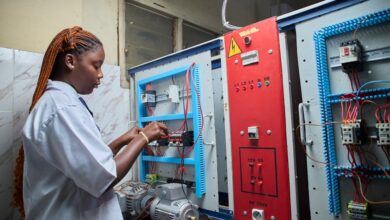The Engine Room: Unpacking Klever’s New KVM

In the fast-evolving landscape of blockchain technology, updates aren’t just incremental changes; they can be seismic shifts that redefine possibilities. For anyone tracking the pulse of innovation in decentralized systems, the latest news from Klever is exactly that kind of moment. Forget just iterating on old models; Klever is ushering in a fundamentally new way to build and interact with smart contracts, marking a pivotal chapter for its ecosystem.
Today, Klever announced a significant leap forward: the Klever Virtual Machine (KVM) is now the new, high-performance execution layer for smart contracts. This isn’t just an upgrade; it’s a foundational redesign, built from the ground up in Rust and compiled to WebAssembly (WASM). For developers and users alike, this means a future where decentralized applications aren’t just theoretically powerful, but practically faster, safer, and infinitely more flexible.
The Engine Room: Unpacking Klever’s New KVM
At the heart of any robust blockchain lies its virtual machine – the engine that processes and executes smart contracts. For too long, many networks have grappled with the limitations of older architectures, often leading to bottlenecks in performance, security vulnerabilities, or a clunky developer experience. Klever’s move to KVM addresses these challenges head-on by adopting a modern, future-proof approach.
The choice of Rust as the primary language for KVM isn’t merely a technical preference; it’s a strategic advantage. Rust is renowned for its unparalleled memory safety and performance, effectively eliminating entire classes of bugs common in languages that don’t enforce such strict rules. This translates directly into smart contracts that are inherently more secure and reliable from the moment they’re deployed. When you combine Rust with WebAssembly (WASM), you get an execution environment that is not only blazingly fast but also incredibly efficient, using fewer resources and offering predictable gas usage. This is a game-changer for dApp developers looking to create applications that can genuinely scale without compromising on cost or speed.
Think about the difference between a classic sports car and a modern electric vehicle. Both get you from A to B, but the latter offers a smoother, more efficient, and often more powerful ride thanks to advanced engineering under the hood. KVM is Klever’s version of that cutting-edge electric engine, purpose-built for the demands of the decentralized web. This isn’t just about speed; it’s about a foundational stability that allows for more complex, more ambitious projects to finally come to life on the Klever Blockchain.
Unlocking New Horizons: Features That Redefine Decentralized Applications
The KVM upgrade isn’t an isolated improvement; it’s a catalyst that unlocks a suite of powerful new features and tools, transforming the Klever ecosystem into a vibrant hub for innovation. Each of these enhancements plays a crucial role in empowering developers and enriching user experiences.
Semi-Fungible Tokens (SFTs): Evolving Digital Assets
Traditional tokens are either purely fungible (like money) or non-fungible (like unique art). SFTs introduce a fascinating middle ground: programmable assets that can evolve based on usage or conditions. Imagine a concert ticket that starts as a simple token, but transforms into a collectible after the event, or a membership token that grants different access levels as your status changes. This capability opens up a world of creative possibilities for ticketing, loyalty programs, in-game items, and dynamic digital identities, moving beyond static token definitions to truly interactive digital assets.
Bridging the Gaps: Seamless Ethereum Connectivity
Interoperability is no longer a luxury; it’s a necessity for any thriving blockchain ecosystem. The new Ethereum Bridge is a critical piece of the puzzle, enabling seamless cross-chain interoperability between ERC-20 tokens and the Klever Blockchain. This means users can move their assets with low fees and fast confirmation times, vastly expanding liquidity and adoption opportunities. For developers, it means access to a broader user base and existing token economies, making their dApps more accessible and functional.
Empowering Developers: Tools, Transparency, and Trust
A truly powerful blockchain is only as good as the tools it provides for those building on it. Klever understands this deeply. The introduction of a dedicated VS Code Extension empowers developers to write, test, and deploy smart contracts directly from their familiar development environment. This significantly streamlines the workflow, reducing friction and accelerating the development cycle.
Equally important for fostering trust and adoption is transparency. The new KleverScan Contract Area provides a dedicated interface for clear visibility and verification of on-chain smart contracts. This allows users and auditors to inspect contract code, ensuring accountability and building confidence in the decentralized applications running on the Klever Blockchain. It’s about making the invisible visible, fostering a safer ecosystem for everyone.
Frictionless Experiences: The KDA Pool Deposit Smart Contract
One common hurdle in the user experience of decentralized applications is dealing with transaction fees. The KDA Pool Deposit Smart Contract elegantly addresses this by allowing projects and partners to fund fee pools for their dApps. This means users can interact with applications without constantly worrying about gas fees, leading to a much smoother and more engaging experience. It’s a subtle but powerful way to onboard more users who might otherwise be put off by the complexities of crypto transactions.
The Strategic Edge: Why KVM Positions Klever for the Future
Looking at these advancements collectively, it becomes clear that Klever isn’t just adding features; it’s building a strategic foundation for the next generation of decentralized applications. The overarching benefits of the KVM update paint a picture of a robust, developer-centric, and user-friendly blockchain:
- High Performance: The Rust-based execution layer means faster runtime and significantly lower resource consumption, translating to quicker transactions and more efficient dApps.
- Enhanced Security: With Rust’s memory-safe architecture, vulnerabilities that plague older smart-contract platforms are minimized, offering a much safer environment for valuable assets and critical operations.
- Multi-Language Potential: The choice of WASM as the compilation target means Klever is future-proofed, with potential future support for a wider array of programming languages. This drastically lowers the barrier to entry for developers from diverse backgrounds.
- Developer-First Tools: From integrated SDKs to the VS Code extension, the focus is squarely on simplifying the entire development lifecycle, making it easier for talented engineers to build impactful applications.
- Cross-Chain Connectivity: The Ethereum Bridge, with upcoming support for TRON, isn’t just about asset transfer; it’s about expanding liquidity, fostering collaboration, and connecting Klever to the broader blockchain universe.
As Duka, Klever’s Product Manager, aptly puts it, “KVM is a defining step for the Klever Blockchain. It brings smart-contract functionality built for real-world scale — with faster execution, greater safety, and a smoother experience for developers and users alike. This update positions Klever as a true infrastructure layer for the next generation of decentralized applications.” This sentiment truly captures the essence of this milestone: building for genuine utility and widespread adoption.
A Vision for a More Accessible Decentralized World
The Klever Blockchain, already a high-performance Layer-1 network powering an expanding ecosystem of products like Klever Wallet, Klever Extension, Bitcoin.me, and VoxSwap, is now more robust and capable than ever. This KVM update isn’t merely a technical upgrade; it’s a clear statement of intent. Klever is committed to making blockchain development faster, easier, and more accessible for everyone, from seasoned developers to everyday users.
By prioritizing security, scalability, and a truly developer-friendly environment, Klever is not just keeping pace with the industry; it’s setting a new standard. The ability to build, audit, and deploy real-world use cases — from marketplaces and DeFi protocols to tokenized assets and immersive games — on a platform designed for efficiency and safety is incredibly compelling. As the decentralized web continues its march towards mainstream adoption, innovations like KVM will be the bedrock upon which truly transformative applications are built, ushering in an era of seamless, secure, and smart digital interactions for millions worldwide.





